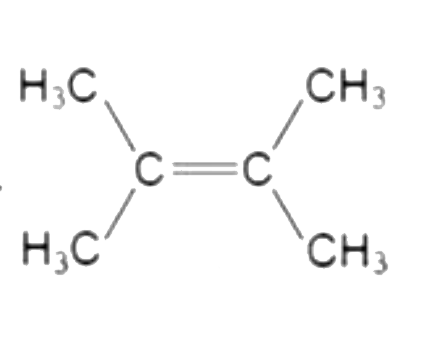The reaction H2C=CH2Ethylene+H2OwaterH3PO4−−−−−−−→300∘/60atmC2H5OHEthyl alcohol is called
Hydration
Sublimation
Dehydration
Substitution
The correct Answer is:A
To determine the name of the reaction where ethylene (H₂C=CH₂) reacts with water (H₂O) in the presence of phosphoric acid (H₃PO₄) to form ethyl alcohol (C₂H₅OH), we can follow these steps:
Step 1: Identify the Reactants and Products
The reactants in this reaction are:
- Ethylene (H₂C=CH₂)
- Water (H₂O)
The product of the reaction is:
- Ethyl alcohol (C₂H₅OH)
Step 2: Understand the Conditions of the Reaction
The reaction occurs under specific conditions:
- Temperature: 300°C
- Pressure: 60 atm
- Catalyst: Phosphoric acid (H₃PO₄)
Step 3: Recognize the Type of Reaction
This reaction involves the addition of water to an alkene (ethylene). The characteristic reaction of alkenes is called an electrophilic addition reaction. In this case, the double bond in ethylene is attacked by water.
Step 4: Mechanism of the Reaction
1. Protonation of Ethylene: The double bond in ethylene acts as a nucleophile and is protonated by H⁺ (from H₃PO₄), forming a carbocation intermediate.
2. Nucleophilic Attack: Water (acting as a nucleophile) attacks the carbocation, leading to the formation of ethyl alcohol.
Step 5: Naming the Reaction
Since the reaction involves the addition of water to an alkene, it is specifically referred to as "hydration." Therefore, the name of the reaction is:
Hydration Reaction
Final Answer
The reaction of ethylene with water in the presence of phosphoric acid to form ethyl alcohol is called hydration.
---
The reactants in this reaction are:
- Ethylene (H₂C=CH₂)
- Water (H₂O)
- Ethyl alcohol (C₂H₅OH)
The reaction occurs under specific conditions:
- Temperature: 300°C
- Pressure: 60 atm
- Catalyst: Phosphoric acid (H₃PO₄)
This reaction involves the addition of water to an alkene (ethylene). The characteristic reaction of alkenes is called an electrophilic addition reaction. In this case, the double bond in ethylene is attacked by water.
1. Protonation of Ethylene: The double bond in ethylene acts as a nucleophile and is protonated by H⁺ (from H₃PO₄), forming a carbocation intermediate.
2. Nucleophilic Attack: Water (acting as a nucleophile) attacks the carbocation, leading to the formation of ethyl alcohol.
Since the reaction involves the addition of water to an alkene, it is specifically referred to as "hydration." Therefore, the name of the reaction is:
The reaction of ethylene with water in the presence of phosphoric acid to form ethyl alcohol is called hydration.
Topper's Solved these Questions
- BOOK - ERRORLESS CHAPTER - HYDROCARBONEXERCISE - ORDINARY THINKING (Objective question) (AROMATIC HYDROCARBON)128videos
HYDROCARBON
- BOOK - ERRORLESS CHAPTER - HYDROCARBONEXERCISE - CRITICAL THINKING (Objective questions)24videos
HYDROCARBON
- BOOK - ERRORLESS CHAPTER - HYDROCARBONEXERCISE - ORDINARY THINKING (Objective question) (ALKENE)129videos
HYDROCARBON
- BOOK - ERRORLESS CHAPTER - HALOGEN CONTAINING COMPOUNDEXERCISE - Critical Thinking (Jee (Advanced) 2018)1videos
HALOGEN CONTAINING COMPOUND
- BOOK - ERRORLESS CHAPTER - IONIC EQUILIBRIUMEXERCISE - JS Jee Section (JEE Advanced (Numeric answer type question))1videos
IONIC EQUILIBRIUM
Similar Questions
Knowledge Check
- Question 1 - Select One
The reaction
R−C∣∣O−RN3H−−−→H2SO4RCONHR+N2 is calledAClaisen- Schmidt reactionBKolbe- Schmidt reactionCSchmidt ractionDKolbe's reacton. - Question 2 - Select One
In this reaction CH3−CH3∣C∣Br−CH2−CH3C2H5ONa−−−−−→Alcoholic
A2-ethoxy-2-methylbutane is the major product in the presence of ethoxide ionBmixture of 2-methyl-2-butene and 2-methyl 1-butene is formed in the presence of ethoxide ionCboth are correctDnone of these. - Question 3 - Select One
CH3CH2−CH3∣C∣CH3−C∣OHH−CH3H2SO4−−−→heatPMajor
What is the major product P in the above reactions?ACH3∣CH2−CH2−CH3∣C−CH=CH2BCH3−CH3∣CH−CH3∣CH−CH=CH3CCH3CH2−CH3∣C∣CH3−CH=CH2DCH3CH2−H3C∣C=CH3∣C−CH3
In the following reaction, three product a, b, c are obtained.
H3C−CH3| C | CH3−CH| OH−CH3H3PO4/heat−−−−−−−→H3−C−CH2| C | CH3−CH (a)=CH2+ +H3C−CH2||C−CH| CH2−CH3(c) View Solution
+H3C−CH2||C−CH| CH2−CH3(c) View SolutionThe major product of the following reaction is :
C6H5CH2−CH3∣C∣Br−CH2−CH3C2H5ONa−−−−−→C2H5OHView SolutionThe IUPAC name of CH3−C∣=CH−CH2−O∣∣C∣ COOC2H5 OH is:
View SolutionIdentify A and B in the following reaction sequence .
CH3−C∣CH3H−CH=CH2+HBr→(A)C2H5O−−−−−−−−→C2H5OH(B)View SolutionThe IUPAC name of CH3−CH∣C3H7−CH∣C2H6−CH∣C2H5−CH3
View Solution

